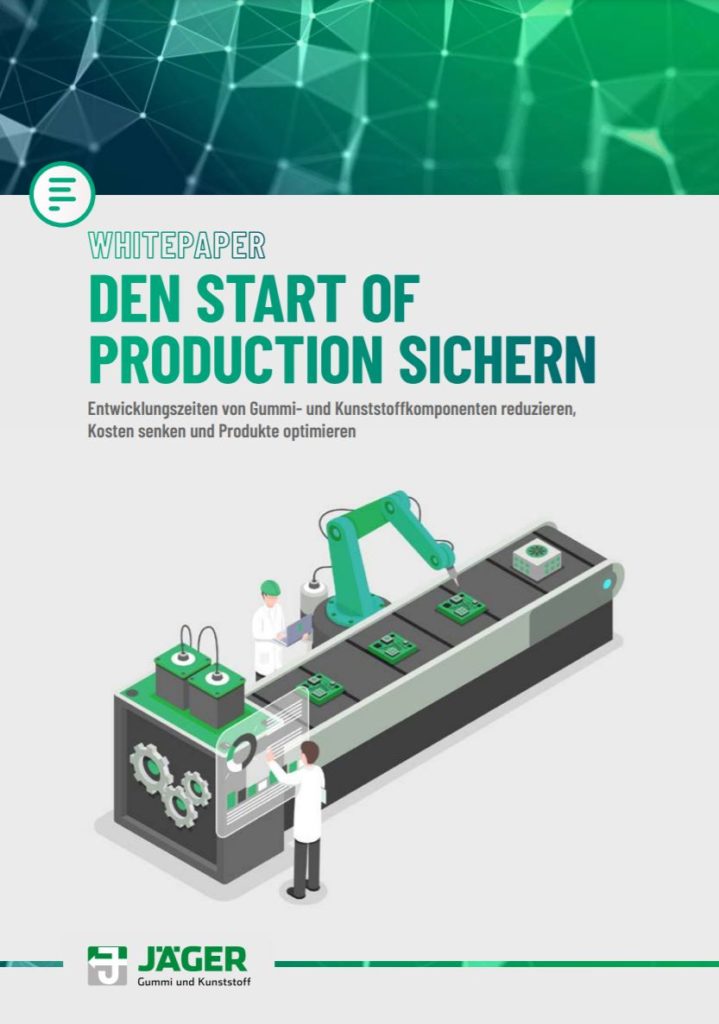
JÄGER Business Blog
What should you look out for?


WHITEPAPER
Find out which factors influence your SOP!
Choosing the right supplier for rubber or plastic components is not easy. There are numerous suppliers on the market whose performance is often difficult to assess from the outside. In addition, suppliers in this area also act as development partners and the proportion of services is correspondingly higher. For this reason, it is advisable to gain an overview of the specifics of the industry before selecting a new supplier for rubber and plastic products.
At the basic process level, supplier selection is the same in all companies. The purchasing department first researches potential suppliers for the materials (based on internal or external information) and creates a short list. It then looks in detail at all the manufacturers on this list, crosses off those that turn out to be unsuitable, and selects the supply partner who best meets the individual decision criteria.
The second phase, supplier evaluation, is particularly challenging in rubber and plastics processing. The reason for this is the low degree of standardization of these materials.
In the metal sector, there are firmly defined products, for example steel grades, which always have the same properties. Purchasing can therefore concentrate on finding a supplier who offers the material required by the design at the most favorable conditions.
With rubber and plastics, this is only the case to a limited extent. Both plastics and elastomers are materials with a wide range of properties that depend on their specific composition. Although there are standardized products (for example, certain types of silicone) that suppliers also have in their portfolio across the board, these are not suitable for all areas of application.
As a rule, customers need rubber compounds or plastics that are individually tailored to their needs, depending on parameters such as ambient temperatures, mechanical loads or vibrations.
Only a few manufacturers are able to design rubber and plastic articles that adequately meet their criteria. This is because the core competencies of most manufacturing companies tend to lie in the metal sector. They simply lack the know-how to deal with plastics or elastomers. If they do need a corresponding component, whether plastic parts, composite parts or molded rubber parts, they call on the consulting services of their suppliers. This circumstance should also be reflected in the selection of suppliers.

Beratungsgespräch auf Grundlage technischer Daten
Hard factors such as price, delivery conditions and product quality also play a major role in elastomers and plastics and should by no means be neglected. However, they are not the sole focus of supplier evaluation. In the procurement of rubber and plastic articles, soft factors are also of high value, even more so than in the metal sector.
As a rule, manufacturing companies are not only looking for a product supplier for plastic components or rubber goods, but also for a development partner who can support them in both design and material selection. Rubber and plastics suppliers are more deeply involved in the value creation process of their customers than is the case in many other industries. Accordingly, the quality of their consulting services and customer service is an important part of supplier selection.
Pay attention to how potential suppliers respond to your inquiry. Reputable suppliers first analyze your requirements and general conditions before submitting a bid. Such suppliers ask questions, communicate with their customers on an equal footing and are not afraid to find unidentified challenges or alternative solutions.
Honesty and transparency are the be-all and end-all in the procurement process. As a rule, there are no elastomers and plastics that meet all customer requirements out of the box. The same applies to delivery times. Currently, the entire German industry is experiencing delivery problems and is openly communicating this. Companies that do not do so are probably not acting transparently toward their customers.
We are talking about an average project involving hoses or seals, for example. Of course, there are applications for which standard materials or components such as o-rings are perfectly suitable. In practice, however, this happens rather rarely.
It is also important that you do not leave the selection of suppliers in the rubber and plastics sector exclusively to the purchasing staff. Although they can negotiate prices and delivery conditions, they can hardly evaluate the advisory part of the cooperation. Very few buyers are able to assess whether the proposed solution from a rubber and plastics supplier meets the requirements of the design. Therefore, in addition to purchasing, you should always get the technical departments on board, at least as far as the technical details are concerned.
The high competitive pressure in the industry is driving many companies to align their procurement with price. As far as plastic and rubber products are concerned, however, this can only be recommended to a limited extent. The low level of standardization makes it difficult for customers to assess the quality of the material in advance. At the same time, suppliers in the low-price sector offer fewer advisory services, so customers sometimes inadvertently select an unsuitable material for their components. In the rubber and plastics sector, a strong price orientation can therefore result in restrictions with regard to product quality.
In addition, there are other decision-making criteria that should be part of the supplier evaluation apart from price. These include, for example, service, delivery reliability, local proximity and good accessibility, if possible with fixed contact persons in customer service to facilitate contact between customer and supplier.
Sustainability has also become an integral part of modern supplier management. Requirements such as the lowest possible CO2 emissions, environmentally friendly materials and a transparent supply chain free of human rights violations are part of every company’s specifications and should be conscientiously reviewed. Not only because of legal requirements, but also because sustainability has become an intrinsic concern for many decision-makers.
In essence, supplier selection for rubber and plastic products is little different from other areas. The process is the same, only the focus is different. Soft factors such as transparency or honest communication at eye level have a higher priority, as rubber and plastic require a higher proportion of consulting.
All molded parts are individually adapted to their intended use; standard products are few and far between. For this reason, manufacturing companies for rubber and plastic are usually not looking for a simple supplier, but for a development partner who can support them in material selection, optimization and design. You should definitely keep this circumstance in mind when selecting a supplier.

Whitepaper: Secure the Start of Production
Learn which factors influence your SOP!

Joachim Reindl is regional sales manager at Jäger, responsible for Austria and the south of Bavaria. He has 45 years of experience in the rubber and plastics sector.

Dieter Lödel has been a field sales representative at Jäger since 2015 and brings 30 years of experience in plastics.
Share this post!
Jäger Gummi und Kunststoff GmbH
Lohweg 1
30559 Hannover
Tel. +49 511 – 53580
Fax +49 511 – 553394
info@jaeger-gk.de
Management:
Dipl.-Ing Sebastian Jäger
Julius Jäger, M.Sc.
Hanover Register Court HRB 59798
DE 813 314 161

Petra Dirlenbach